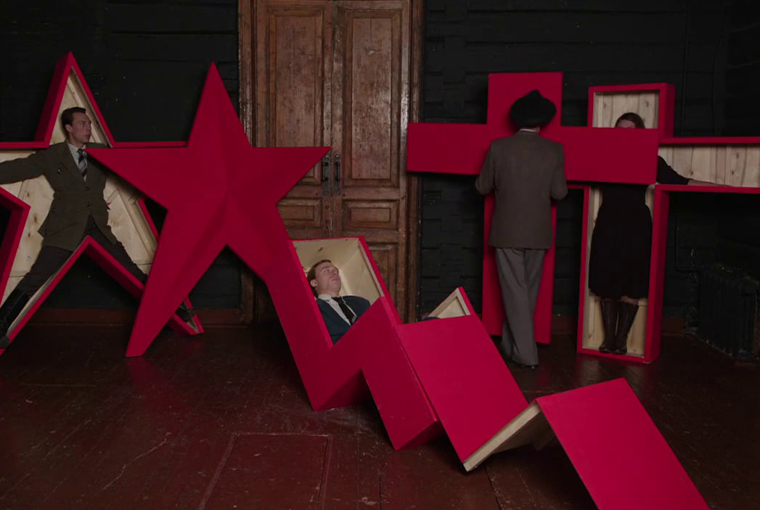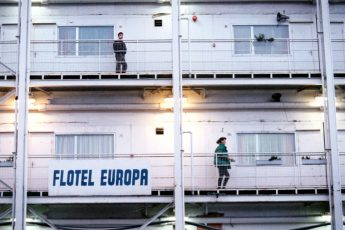The World Is a Stage
Alexei Fedorchenko’s Angels of Revolution (Angely Revoluciji, 2014)
Vol. 63 (March 2016) by Moritz Pfeifer
In 1930, the Soviets went into Kazym, a forlorn region in Western Siberia and home to indigenous tribes such as the Khanty and Nenet. Up to then, the northern peoples, most of them reindeer herding communities, had been spared by Stalinist collectivization policies. But “cultural bases” (kul’tbazy) were established at Kazym and Lariak in the early 1930s that were meant to lure Khanty people into villages where they could more easily adapt to a modern lifestyle – with access to schools, medical centers, and stores – and participate in industrial and agricultural production. The nomadic herders, however, resisted forceful resettlement and in 1933 a revolt in Kazym resulted in Khanty taking Russian officials hostage, fleeing to the tundra, and eventually being arrested and in many cases killed.
Until recently, the event did not stir much attention in Russian historical memory. In Soviet times, the story had been taught in schools in Kazym as an incident of betrayal. But with the publication of Eremei Aipin’s Mother of God in Blood-Red Snows (Bozh’ia Mater’ v krovavykh snegakh, 2002), the fate of the Khanty people and their political protest received a more truthful commemoration. In 2009, the book was adapted for screen by Oleg Fesenko, whose Red Ice: Tale of Ugra Hunts (Krasnyi led. Saga o khantakh Iugry, 2009) frames the event in a Shakespearean love story between a Khanty girl and a Soviet missionary. The film romanticizes the documentary ambitions of its source and portrays the Khanty people as noble savages in a somewhat oversimplified demonstration which tries to refute the Soviet idea that primitive peoples should be integrated into civilization at all.
Many representations of indigenous people on screen reflect this dilemma. Portrayals that are too idyllic risk romanticizing primitive life as a golden age of innocence and happiness, as civilization without its vices. On the other hand, representations centered on poverty and hardship may reduce primitive society to a life without virtues, thereby legitimizing the idea that “underdeveloped” forms of existence need to be “saved” from their own demise by superior societies.
Fedorchenko’s Angels of Revolution tries to avoid this trap in a baroque comedy which not only pokes fun at the Soviet’s perception of their cultural supremacy, but also at the Khanty’s naïf superstitions and pagan rituals, which are ridiculed as just another kind of idealism, albeit one without colonialist ambitions. Fedorchenko satirizes the missionaries by representing them as a group of avant-garde artists who are sent to the edge of the tundra to teach to the incredulous Khanty the aesthetic fruits of revolutionary art. Instead of staging the event in an epic clash of civilizations, Fedorchenko’s clash-of-art-worlds approach produces some of the film’s most comical moments, for example when the artists force the Khanty to stage a play about animals struggling in the cold (with an additional pun on Brecht’s didactic theater). Nevertheless, the two cultures somehow coexist and even miraculously fuse. Later theater productions that stage Bolshevik fantasies alongside the folktales of the Khanty are oddly appealing, maybe because they add the right amount of magic to Socialist realism.
The artists share more with the Khanty, however, than what is revealed by their creative fusions. In a lengthy flashback, Fedorchenko sketches their ludicrous artistic biographies: alongside soldier-turned-artist Polina (Darya Fedorchenko) are composer Ivan (Oleg Yagodin), filmmaker Pyotr (Pavel Basov), photographer Zakhar (Georgi Iobadze), architect Nikolai (Konstantin Balakirev) and theater director Smirnov (Alexei Solonchyov). Except for Ivan (who is the only one refusing to go to Kazym), they all had their own violent clashes with ideology. Coming of age in a political environment of conscription, denunciation and purges, artistic obedience became essential for their own survival. In light of this violent past, it is no wonder that the missionaries don’t reach out for diplomacy when the Khanty no longer want to play along. Violence is transitive. When one of the artists says that “only art can domesticate the Khanty under Soviet power”, it becomes clear that they have given up on the utopian idea of art as a means for social reform that was at the center of the Russian avant-garde. Just like their own creative endeavors were forcefully undermined by Soviet Gleichschaltung, they resort to coercion when confronted by unwilling executors. But so do the Khanty, whose “sacred way of life” and obedience to their Gods is equally merciless.
With Angels of Revolution, Fedorchenko does not only portray a convincing genealogy of violence, he also provides an original answer to the complex questions of how to represent indigenous civilizations and ethnic violence. Staging both the missionaries’ and Khanty’s universe in the theater enables Fedorchenko to uncover their respective cultural and political fantasies as “formal” rather than natural or innate dispositions. Perhaps this is why he plays out the final battle with puppets. This re-enactment depicts the tragedy of bloodshed as an event reflecting the symbolic structures of organized life. Instead of shocking the viewer with explicit violence, we are invited to understand whose interests were served by those structures.




Leave a Comment